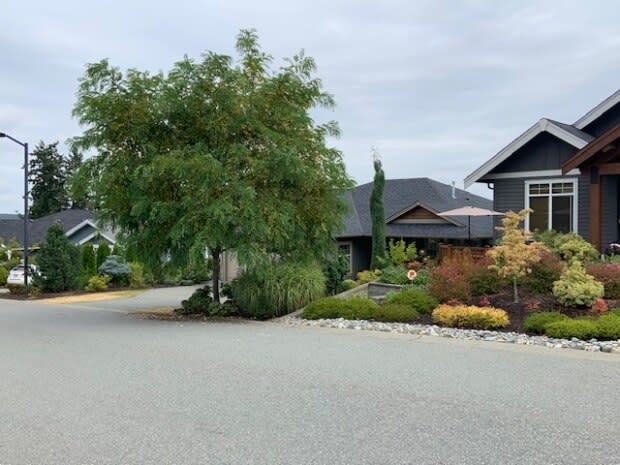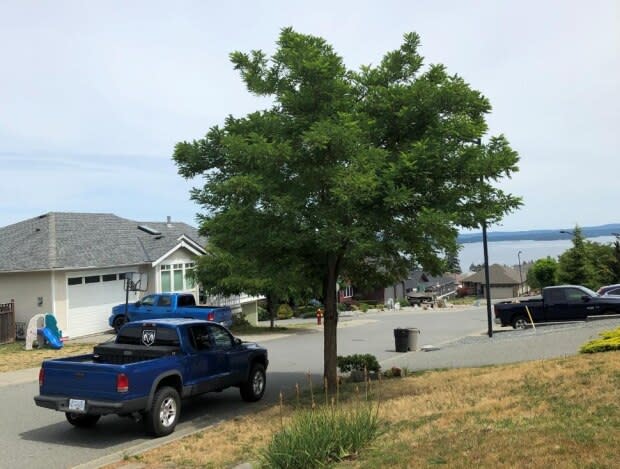Residents battling roots of invasive trees seek help from city hall
Residents of a Vancouver Island neighbourhood battling to contain the destructive roots of invasive ornamental trees are demanding the town act to remove the species and are questioning why it was allowed to be planted in the first place.
The roots from black locust trees have been ripping up driveways, choking pipes and sprouting unsafe roots in yards, according to Ladysmith, B.C., resident Chris Fritsch.
"I have no idea why [the developer] chose that tree. It's not found anywhere else in town," said Fritsch, who lives at the corner of Halliday Place and Fourmeaux Crescent.
The trees were planted when the area was developed for housing 15 years ago.
'Tree killer'
The non-profit Tree Canada deems the black locust a "tree killer," with roots that can grow extremely quickly even in poor soil, as they contain nitrogen-fixing bacteria. They introduce more nitrogen to the soil, inviting other non-native plants to invade the area.
The tree reproduces through suckers in its roots, producing a dense concentration of new trees that can overshadow and kill other young plants, Tree Canada says.
A report from the Ontario Invasive Species Council says the tree originates in the southern United States and has been introduced to various places in B.C., Ontario and east to Nova Scotia.
Cutting down a tree will cause its roots to rapidly reproduce new trees, and it can take years of herbicidal control to destroy the roots effectively.
Currently, the black locust is prohibited in Massachusetts.

Fritsch said after he noticed water pooling in his backyard, black locust roots were found to have invaded the drainage system on his street. The municipality soon found the drainpipe was being "devoured by the roots," said Fritsch.
He said that roots have now crept up to the foundation of his neighbour's house — adding that if they can cripple driveways, they can certainly damage a home.
Neil Stuart said there are two black locust trees on either side of his property and that he's complained about them to the Town of Ladysmith for years.
"I'm appalled," he said. "I took a handsaw and [cut] around the base of the tree. It's supposed to kill it, but it's still alive."
Stuart said his neighbour routinely hacks away new trees that have sprouted on his lawn. He said the municipality removed a tree and paid for a new driveway when his uncle, who lives down the road, tore up the driveway to expose the roots.

'I basically ripped up her whole yard'
Todd Smith, an arborist in Nanaimo, B.C., says he's had to remove a number of black locust trees from the mid-Island area.
"I've had nothing but harsh experiences because … their root systems are like something I've never seen," he said.
Smith recounted how removing a 20 centimetre-tall tree was an ordeal because the roots had scoured a resident's entire yard. He said he had to remove the tree with a stump-grinder, then tie a rope around the main roots before pulling them out by the metre.
"I basically ripped up her whole yard," he said.
Fritsch said the municipality "didn't do their due diligence in discovering that this tree is listed as invasive."
"It's simply a matter of Googling it and … seeing whether it's appropriate for landscaping purposes," he said.
Ladysmith Mayor Aaron Stone said a number of residents voiced their concerns at a town council meeting last week, and he's "directed staff to come back with options to replace the trees with something that's … more appropriate."
Stone said council now has "a little bit more background on the trees," and that money can be re-allotted in the budget to remove them.
"I don't believe it's an accepted tree in any new developments here," he said.
"It only becomes more difficult as time passes so it's good that we take action and get it dealt with as soon as possible."


